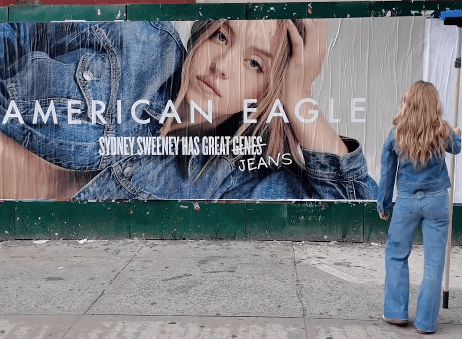American Eagle Pushes Aryan Nostalgia In Controversial Ad
American Eagle Pushes Aesthetic Of Aryan Nostalgia In Controversial Ad

It starts slow. She’s on her back, bathed in soft light, legs slightly parted. The camera pans up, denim hugging her hips, her flat white stomach rising ever so gently as she zips her jeans. Her waist arches just enough to catch the light. A blonde halo frames her face.
The scene evokes questions: What has she just finished doing? Getting dressed, or being undressed? Is this post-coital? Post-photoshoot? Post-conquest? The ambiguity is deliberate, crafted for a gaze that wants both innocence and implication.
Then her voice floats in, calm, calculated, almost instructional: “Genes are passed down from parents to offspring, often determining traits like hair color, personality, and even eye color.” The camera keeps climbing, past her stomach, her chest, up to her face. “My genes are blue.”
And right on cue, it lands on her eyes. Blue. Icy. Intentional. Eyes the color of colonizer daydreams. Hip bones sharp enough to cut through history. She stares into the lens with the confidence of a body that knows it’s been worshipped by empire for centuries.
Sydney Sweeney doesn’t say “white supremacy,” but her image does.
The tagline, “Sydney Sweeney Has Great Jeans,” flashes like a punchline in bold American Eagle branding. The ad went viral instantly, driving huge buzz and stock gains, but drew fire for messaging that many interpreted as racially charged.
Critics argue that the “great jeans” setup paired with Sweeney’s blonde hair, blue eyes, and slim physique evokes eugenics and white supremacist imagery, likening it to Nazi-era propaganda and modern MAGA dog whistles. Some drew comparisons to Brooke Shields’s controversial Calvin Klein ads from the 1980s, calling the campaign tone-deaf and retrogressive against the current cultural emphasis on diversity and inclusion.
Others dismissed the backlash as an overreaction and defended the campaign as a tongue-in-cheek, anti-woke marketing move, branding it as playful nostalgia and a rejection of oversensitivity.
Either way, the denim wasn’t the point. Whiteness was.
You’d think American Eagle would’ve learned from the long, racist tradition of selling whiteness as aspirational. But nope. They peddled this soft-focus eugenics fantasy as a love letter to the days when American branding didn’t even pretend to care about inclusion. In 2025, that double entendre—genes/jeans—doesn’t just sound tone-deaf. It sounds like a dog whistle.
The phrase “great genes” in this context is more than a pun; it’s a wink to a long history of white supremacist ideology that MAGA-types increasingly embrace openly. Think replacement theory, build the wall, protect our women. It taps into that biosocial panic that white conservatives have been screaming about: birthrates, immigration, losing the country. MAGA isn’t just about politics. It’s about lineage. Bloodlines. Heritage. And here comes an ad campaign practically whispering, “Don’t worry. Our genes are still strong.”
This ad lands at a time when white nationalist talking points have gone mainstream. When “replacement theory” is being laundered on Fox News. When assaults on reproductive rights are being framed as moral imperatives to ensure white women produce more white babies. When the Supreme Court is rolling back civil rights gains, and when MAGA’s clarion call to “Make America Great Again” is really just a call to remake it white again.
We are in an era where nostalgia is weaponized, grievance is a campaign strategy, and whiteness is being rebranded as a scarce and endangered resource. Against that backdrop, American Eagle didn’t just miss the mark, it gleefully planted a flag on it, zippered it up in low-rise denim, and told us to smile.
Brands like American Eagle don’t stumble into controversy; they engineer it. They know exactly what they’re doing when they cast a blonde, blue-eyed bombshell and wrap her in a pun about “great genes” in a post-Roe, post-affirmative action, post-truth America. They know the images will circulate. They know the outrage will trend. In an economy where attention is currency and culture wars sell product, provocation is a marketing strategy.
The goal isn’t to avoid offense, it’s to polarize, provoke, and profit. Because in this climate, a brand doesn’t need to be beloved. It just needs to be loud. And for a fading mall store with sagging relevance, nothing screams louder than a white girl in low-rise jeans whispering sweet eugenics to a generation raised on aesthetic vigilance.
This isn’t the first time white femininity has been deployed as both symbol and strategy. From silent film starlets to wartime pinups to the “All-American Girl” of every shampoo commercial, white women, especially young, slim, blonde ones, have long served as the face of America’s moral center and racial fantasies. Their bodies have been used to sell everything from cigarettes to democracy, always coded as pure, desirable, and worth protecting.
But they’ve also been weaponized to incite violence, uphold segregation, justify war, and police the boundaries of belonging. The Sydney Sweeney ad doesn’t just tap into that lineage; it updates it. Her face becomes a canvas onto which the nation can project its nostalgia, its fears, its reproductive panic, and its racial delusions. She is the product. A beautiful cipher for an ugly tradition that keeps getting rebranded every time the empire feels threatened.
Sydney Sweeney didn’t write the script or direct the camera. But she was cast for a reason. Her image, already steeped in cultural controversy thanks to her family’s public MAGA affiliations and Blue Lives Matter-themed celebrations, makes her a loaded symbol. She exists at the intersection of Hollywood innocence and right-wing comfort: blonde enough to soothe, sexual enough to sell, familiar enough to mainstream America’s racial subconscious to feel like “home.”
That’s what makes the casting so potent. It’s not just about her beauty, it’s about what her beauty means, who it flatters, and what anxieties it calms. When American Eagle placed her at the center of their campaign, they weren’t just banking on her stardom; they were banking on the psychological safety her whiteness offers in a moment of demographic panic and cultural upheaval.
This ad also echoes a much darker legacy: Donald Trump’s “good genes” dogma, Jeffrey Epstein’s weaponized girlhood, and America’s long habit of hiding predation behind whiteness and beauty. When a fashion campaign starts to look like a crime scene from 2003, complete with the same aesthetic, the same silence, and the same players, we should all be asking: What are they really selling?
The “good genes” obsession echoes Trump’s brand of eugenics. Trump has repeatedly referenced “good genes,” his own and those of other white people, as markers of intelligence, beauty, and superiority. He’s praised his “German blood,” claimed success is hereditary, and spoken admiringly of people with “great genes” as if humanity is a horse race.
The Sydney Sweeney ad parrots that exact language. It’s a nudge to the same elitist, pseudo-eugenic ideology that Trump promotes: some people are just better, and of course, they’re white, blonde, blue-eyed, and American. This is the cosmetic layer Trump paints over his moral rot—selling whiteness and genetic excellence as both natural and aspirational. This campaign does the same.
In this ad, we also see infantilization and fetishization of white girlhood. Trump’s entire Epstein-adjacent orbit is steeped in the fetishization of young, white, blonde women. Sydney Sweeney embodies the archetype that both Trump and Epstein surrounded themselves with: nubile, innocent-looking, ambiguously aged, sexually suggestive, and deeply palatable to the white male gaze.
The ad’s Y2K aesthetic, bare midriffs, and flirty tone harken back to the era when Epstein was operating with impunity, and when Trump was partying alongside him. That blue jeans/blue eyes fantasy is not just a style, it’s a signal. A cultural code that associates whiteness, thinness, youth, and sexual availability with both desirability and moral worth. It’s the same aesthetic used to cover up and sell exploitation.
The Epstein saga exposed how powerful white men commodified white girlhood, using it to launder their sins and distract from the systemic harm they were doing. This ad taps into that same cultural reflex: offering up a blonde ingénue as a nostalgic, wholesome figure, when the aesthetic itself has been used to shield predators, not expose them. Trump’s public persona was propped up by his ability to surround himself with “the right kind” of women. Epstein used his too-young companions as social currency. Both operated in a world where the appearance of white femininity bought silence.
Trump and Epstein moved in circles that relied on performative innocence, from pageants, prep schools, country clubs, and modeling agencies. American Eagle is now channeling that same world by pushing an ad that feels vintage, flirty, and safe. But when you strip back the pun and the polished lighting, what you’re left with is a barely disguised celebration of the same racial and gendered hierarchies that enabled abuse.
So no, this wasn’t just an ad about denim. It was a nostalgia bomb wrapped in low-rise jeans and blonde ambition. A soft-core reboot of the same old story: whiteness as default, whiteness as desire, whiteness as destiny.
Sweeney didn’t just zip up a pair of pants; she zipped up an entire racial fantasy and winked at the camera while doing it. And American Eagle didn’t miss the moment. They read the moment. Then they sold it back to us with a smirk, a hip tilt, and a not-so-subtle reminder: the empire always finds new ways to stay on brand.
Sydney Sweeney may have great jeans. But this ad has bad taste, bad politics, and a worse sense of history. And if this is what American Eagle thinks will bring them back to cultural relevance, then they’ve got bigger problems than denim sales. They’ve got a branding crisis rooted in the delusion that whiteness is still the blueprint for beauty.
Dr. Stacey Patton is an award-winning journalist and author of “Spare The Kids: Why Whupping Children Won’t Save Black America” and the forthcoming “Strung Up: The Lynching of Black Children In Jim Crow America.” Read her Substack here.
SEE ALSO:
Sydney Sweeney And American Eagle Ad Invokes Racist Ideology






